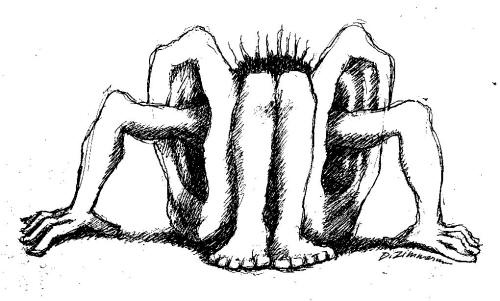|
You are reading the older HTML site Positive Feedback ISSUE 46november/december 2009
Audiophrenia
The fine foothill City of Denver (CO) has been once again destination of the ritual pilgrimage to that shrine of my consuming obsession—the Rocky Mountain Audiofest (RMAF). There, in communion with a few thousands other chronic sufferers of my malaise, I spend nearly 4 days in ecstasy whilst gliding from chapel to blessed chapel... oops sorry, I meant from fine suite to even finer suite, holy golden Reliquary at hand... well, it was my golden CD sampler after all, in one of the most revered of sanctuaries of the Faith... sorry again, I meant in that excellent Tech Centers Marriott Hotel, where according to the latest official statistics, over 3700 long suffering, and regrettably mostly male, and ever more visibly middle-aging audiophiles faithfully return in their futile quest to rid themselves of their strange obsession, or as that primary goal proves invariably impossible, at least to reach a modicum of enlightenment and a glimpse at that most elusive of inner sancta and archetypal repository of ineffable truths: audio Nirvana. What a disconcerting sight we were: during the day walking in rapturous trance from suite to suite. In the evenings deeply immersed in subtle disquisitions on the nature of the most esoteric arcana of the art, whilst lovingly nursing the penultimate tankard of ale in the bar—"just ice-water with a half dozen twists of lime for me, thank you!" How many audiophiles can dance on the head of a diamond needle? Do they double in number if you thrice treat the needle cryogenically in liquid Helium, then dip it in quantum dots and gently rub it on a disk of mpingo wood? Why insist on flamed maple for isolation platforms in the name of the Cremonese luthiers, when that supreme of Cremonese masters, Antonio Stradivari himself, and the Milanese Carlo Giuseppe Testore, just to name a few, cheerily diverted themselves with the lowly poplar, which grew like the proverbial weeds along the banks of the river Po, whilst achieving grand results? Does Bentley-black lacquer truly benefit the Sonics of high-end tube preamplifiers? Should Santos palisander rosewood be sanded and re-sanded down to 3200 grit between coats of hand-applied marine-grade tunc oil, when used to complement the beauty of the ultimate exotic tube linestage, or does that outdoorsy bristly 'unshaven' look and feel confer the device some ineffable audible prowess? Should we seek components that have been lovingly hand-soldered point-to-point by barefooted Cistercian monks in a forlorn Swiss high mountain pass ever buried under avalanches, or can true high-end quality be yielded only inside space age mil-specked clean room numerically-controlled robotic assembly lines? Is my aircraft-grade milled Aluminum billet chassis 'harder 'n yourn?' How to break the bad news to a proud sound engineer that her protégée had almost succeeded in assassinating a perfectly good Steinway grand piano during her pitch battle with Beethoven's Hammerklavier sonata Op. 106? Does quantum physics play a hereto unexplained major role in power cord design and engineering? Will 180 grams analog vinyl records forever reign supreme, or shall they soon be dethroned by disembodied digital bits, electromagically stored in some solid-state phase-glass medium, whose physical properties are buried in an alphabet soup so thick to make this retired IBMer blush in confusion? Is your drinking companion an audio pariah, perhaps a shifty-eyed and weak-chinned follower of the New Age green church of class D ICEpower-based amplification, or are 300B tubes alone blissfully permitted to cross the threshold of his manly abode, so to yield supreme ecstasy while he chants in ecstatic fervor "once a tuboholic... "? Are the rumors true that British investigators operating under contract for a major audio cable manufacturer, from mysterious secure facilities with submarine warfare connections, may be close to cracking the final secrets of audio distortion? The non-initiated, who may be listening in by happenstance at the bar, shall more than likely equate such lofty and only partially jesty discussions to the absurd ravings of an aging population of borderline lunatics, who must have obviously far too much leisure time at their disposal, combined with a dangerously cavalier confidence in the preternatural health of their personal finances. Thus shocked, the stalwart citizen may even consider the civic merits of alerting the local authority to an Imminent and Present Danger to the well being of the civilian population of Colorado at the hands of such elderling throng. Yet, a true audiophile will deem many such topics admittedly droll, but also subtly relevant, probably fascinating, mostly vital, and of potentially momentous importance to his never-ending quest. Interestingly enough, the worried misgivings shared by most 'gentiles' for what amounts to marginally erratic behavior and often absurd financial proclivities of my sound-loving brethren may be, by sheer serendipity, not completely out of line with the findings of peer-reviewed investigations of the most scholarly kind. I should like to point the gentle reader to some little known seminal research work on what is often referred to as Audiophilia Nervosa in the common parlance, more formally named Degenerative Audiophrenic Chorea or DAC). This is an extremely debilitating condition, whose hereditary sex-linked predisposition is finally triggered into full morbidity and modulated by a low mass sub-viral infective agent. The syndrome was first identified and described in 1989 by a team of investigators lead by the Helvetic scholar Aloysius Q. Schmaltzenstein Gavronsky and the late clinical psychiatrist Dr. Peter Scialli (PhD). [See: Aloysius Qwantz Schmaltzenstein Gavronsky, Peter Scialli (PhD), et Al. Prionic modulation and Sex-linked Predisposition in Late Onset Degenerative Audiophrenic Chorea (Acta Medica Refutata, vol 35, No. 4, pp. 435 - 459. Appenzell (CH), 2017]. The authors describe DAC as a acute disturbance of the central nervous system, usually having an onset in very early middle age, and characterized by involuntary muscular movements, uncontrollable usage of plastic cards and other instruments of personal credit, increasingly severe and expensive audio delusions, disastrous lapses of financial common sense, and general progressive cognitive deterioration, accompanied by frequent mewling, drooling, and ritualistic genuflection and prostration in front of gleaming audio components.
Degenerative audiophrenia attacks the cells of the basal ganglia, clusters of nerve tissue deep within the brain that govern coordination, as well as the cortex, which governs common sense in the general population. The onset is insidious and inexorably progressive; no cure is known, and only palliative treatments are available through certain shady internet-based purveyors, as well as other cranks, crackpots, and plain quacks parasitizing the community at risk. Psychiatric disturbances range from personality changes involving compulsive and absurdly costly component purchases, or allegedly highly desirable yet equally unaffordable modifications of audio equipment, in the absence of which the sufferer experiences a variety of psychological symptoms, ranging from minor apathy and irritability, to major manic depressive and schizophreniform episodes. Motor manifestations include flicking movements of the upper extremities towards billfolds and credit cards, as well as uncontrolled signing of any audio sales slips, a lilting gait in front of high-end audio stores, and motor impersistence (inability to sustain a motor act such as tongue protrusion), unless ever-more-frequent, progressively expensive, and most invariably futile upgrades to the patient's audio system are obsessively and compulsively applied.
In 1989 the gene responsible for the disease was located on the
"Y" chromosome
by Schmaltzenstein-Gavronsky and Scialli. While in the general population the
gene remains non-expressed, exposure to a 44,000 Dalton recently evolved variant
of the rogue prion protein—responsible for the devastating
Creutzfeldt-Jakob disease, also known as spongiform encephalitis, and
kuru in Papua New Guiney—triggers massive gene expression and partial gene
hypercopy: a small segment of code is, for some The prognosis is rather bleak. Sufferers invariably end their days socially isolated, divorced, indigent, semi-catatonic, barely surviving under highway bridges while prostrated in front of old warn photographs of their former audio systems, while immersed in a permanent REM state, dreaming of evermore extravagant and ludicrously expensive system upgrades. Aloysius Postscript: The real Dr. Scialli himself suffered of the malady in full blown form. He often answered my sometimes more than daily audiophrenic phone calls with the formal greeting: "DAC hotline, please state your emergency!", or with a frantic warning: "The prions are swarming!". Almost exactly 2 years ago, just 1 week after ecstatically succumbing to the latest massive prionic re-infection at RMAF, and to the subsequent unavoidable ravages of audiophrenia in the form of the purchase of a set of brand new Vienna Acoustics Strauss speakers--gorgeously finished in blond beech wood--Peter was informed by physicians that he would be soon claimed by a somewhat more serious ailment. After just 6 months he left us for the Great Audio Show at the end of the Universe, where prions and Audiophrenia are no disease, and instead power the eternal Music of the Spheres.
|



 reason, copied over and over.
Genetic and audio counseling is extremely important, since 50% of the
male
offspring of an affected parent inherit the gene, which inevitably leads to the
chorea as soon as the subject is exposed to high concentrations of high-end
audio components worth of such an appellation, where semi airborne populations
of highly infectious prion particles are known to nest and swarm with densities
as high as 176,000,000 per cubic inch.
reason, copied over and over.
Genetic and audio counseling is extremely important, since 50% of the
male
offspring of an affected parent inherit the gene, which inevitably leads to the
chorea as soon as the subject is exposed to high concentrations of high-end
audio components worth of such an appellation, where semi airborne populations
of highly infectious prion particles are known to nest and swarm with densities
as high as 176,000,000 per cubic inch.